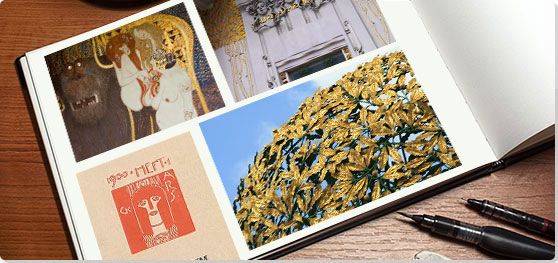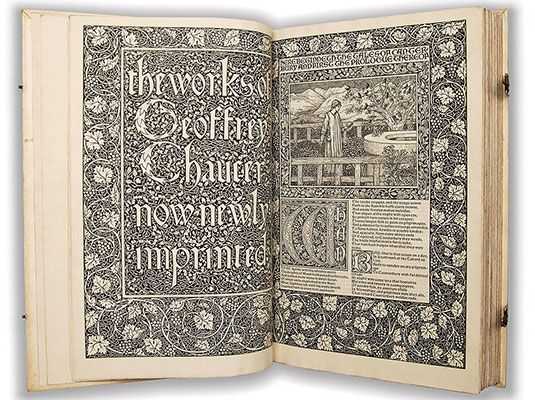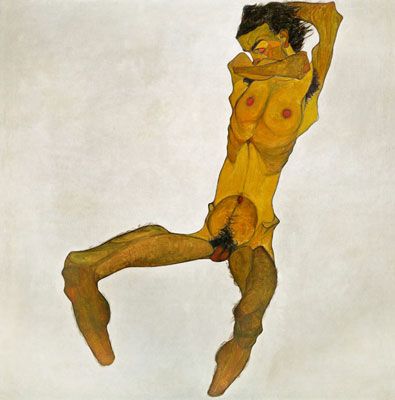Summary of The Vienna Secession
The formation of the Vienna Secession in 1897 marked, quite accurately, the formal beginning of modern art in Austria - a nation at the time noted for its attachment to a highly conservative tradition. It was the coalescence of the first movement of artists and designers who were committed to a forward-thinking, internationalist view of the art world, all-encompassing in its embrace and integration of genres and fields, and - highly idealistically - freed from the dictates of entrenched values or prevailing commercial tastes. Led at the beginning by Gustav Klimt, the Secessionists gave contemporary art its first dedicated venue in the city. This, in concert with their official journal Ver Sacrum, not only introduced the Austrian capital to their work, but that of contemporary and historical art movements on a global scale.
The Secessionists' work provides in large part the visual representations of the new intellectual and cultural flowering of Vienna around 1900, in fields as diverse as medicine, music, and philosophy. Before long, however, internal divisions and difficulties arising from the commercial side of the Secessionists' work ultimately fractured the group's monopoly on the scene for contemporary and decorative arts. Nonetheless, even today the Secession remains a key forum in Austria for the promotion and discourse surrounding contemporary art.
Key Ideas & Accomplishments
- The Vienna Secession was created as a reaction to the conservatism of the artistic institutions in the Austrian capital at the end of the 19th century. It literally consisted of a set of artists who broke away from the association that ran the city's own venue for contemporary art to form their own, progressive group along with a venue to display their work.
- The Vienna Secession's work is often referred to (during the years before World War I) as the Austrian version of Jugendstil, the German term for Art Nouveau, and it is the work of its members in association with that style that has contributed most to its fame, particularly outside of Austria. The Secession's most dramatic decline in fortunes occurred at virtually the same time that Jugendstil fell out of style elsewhere in Europe. When most people speak of the Vienna Secession, they are usually referring to the initial period of its history between 1897 and 1905.
- The Secession was in large part responsible for the meteoric rise to international fame of several of its members, including Gustav Klimt, Joseph Maria Olbrich, Koloman Moser, and Josef Hoffmann, who helped to a large extent put Austrian art back on the map during the first two decades of the 20th century and beyond.
- The Secession's building created the first dedicated, permanent exhibition space for contemporary art of all types in the West. It gave a physical form and geographic location to designers committed to narrowing the gap in prestige between the fine arts of painting, sculpture, and architecture and the decorative and graphic arts, along with encouraging the exchanges between these genres.
- Since the Secession was founded to promote innovation in contemporary art and not to foster the development of any one style, the formal and discursive aspects of its members' work have changed over the years in keeping with current trends in the art world. It still exists and its famed building still functions as both an exhibition space for contemporary art and a location that displays the work of its famous founding members.
Artworks and Artists of The Vienna Secession
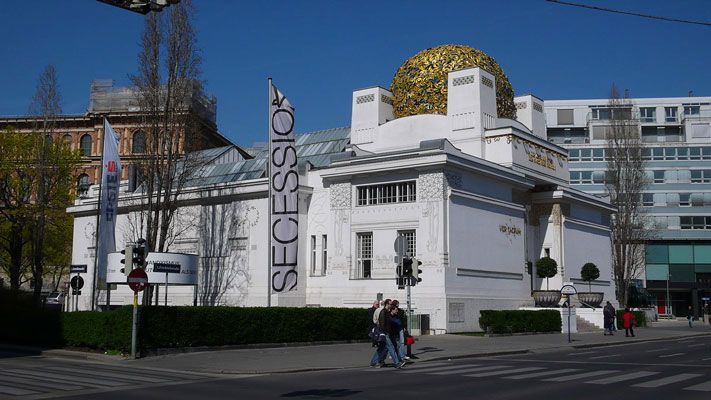
Secession Building Vienna
The Secession Building in Vienna is the movement's physical and spiritual home and its permanent visual form. Designed by Josef Maria Olbrich, a young architect and former student of Otto Wagner, the building, located in a culturally vibrant part of Vienna, needed to hold its own against several larger institutional structures. Its somewhat unconventional appearance led detractors to nickname it "Mahdi's Tomb" or the "Assyrian Convenience," but its location on the former site of a vegetable market also led to the nickname of "The Golden Cabbage" for the lattice of leaves in the dome. The leaves appear much like the stylized crown of foliage at the top of a tree that seems as if breaking through the roof of the building - much like the Secessionists were themselves breaking free of the mold of the display spaces that literally contained (and constrained) art in Vienna - as also emphasized by their journal Ver Sacrum (Sacred Spring), whose title appears to the left of the entrance and references the ancient Roman rituals of the founding of new communities from old ones.
Above the entrance read the German words "Der Zeit ihr Kunst - der Kunst ihr Freiheit" (To the Age its Art; to Art its Freedom), a clear reference to the revolutionary nature of the Secession as an institution devoted to the aesthetic expression of the age, with the implication that for contemporary art, that expression will naturally change. One can see the abstracted forms of the gold foliage, along with the thin trunks of trees also outlined in gold, around the facade, as if to evoke the idea of a protected glade for viewing the artistic work inside. The use of gold on white arguably emphasizes the purity of the space as well as the precious nature of the art.
Lit by skylights, the interior of the Secession Building functioned as a highly effective display space. Movable partitions maximized spatial flexibility for the frequent changes in exhibitions of the Secession and foreign artists. Its floor plan was divided originally into three parts: a rectangular central space flanked by side aisles, much like a Roman/early Christian basilica. One might thus see the building as a kind of temple for contemporary art - the only such space specifically and permanently dedicated to such a purpose at that time. Its flexibility reflected the inherently changing and unpredictable nature of contemporary art itself, in virtually every respect, and thus privileged no individual style, movement, or trend over another. Ironically, however, it achieved such effectiveness by relying on a very old spatial layout, thereby suggesting the inability of contemporaneous artistic practice to completely break from established tropes.

Aureol
Auchentaller joined the Secession at its inception, but, as one of Gustav Klimt's supporters, broke with the group over the search for a gallery space in 1905. This poster, from the year the Secession Building was built, demonstrates the way that Secessionists from the beginning exhibited links with foreign artists - in this case, the Art Nouveau graphics that were sweeping through Europe. This advertising poster for hair coloring draws on French examples, particularly the techniques of Henri de Toulouse-Lautrec: the nearly-silhouetted figures in the background whose figures all seem to blend into each other; the flattened planes of color with minimal shapely articulation besides their well-defined outlines; the use of three colors, specifically black, golden yellow, and red; and the curvilinear typeface at the center. It also demonstrates the use of color lithography on a large scale, another technological innovation of the era.
Likewise, this piece also shows the way that Secessionists accepted the entry of the poster into the realm of fine art, something that Toulouse-Lautrec and other graphic artists in France like Jules Cheret, Alphonse Mucha, Pierre Bonnard, and Theophile Steinlen had achieved by 1900. The work of the Secessionists in large-scale graphic advertising and their reproduction in Ver Sacrum points to how in Vienna the gap in prestige was narrowing between graphic art and the traditional arts of painting and sculpture - at least in terms of talent if not in terms of monetary compensation - one of the primary goals of the Secession. Auchentaller himself would go on to produce numerous other posters over the next decade.
Here there is an interesting break with French posters, which tend to generally abstract all aspects of human figures in an almost cartoonish manner. Auchentaller has instead decided to keep a highly plastic, naturalistic depiction of the faces in this poster, particularly the woman at the center, which has the effect of animating the movement of the figures overall. It also arguably makes the connection with the viewer more tangible, as if to show off the enhancement of the woman's natural glow from using the product advertised, beyond merely her hair. In this respect, therefore, Auchentaller shows himself not as a derivative artist, but one sensitive to the demands and requirements of the individual commission.
Lithographed poster
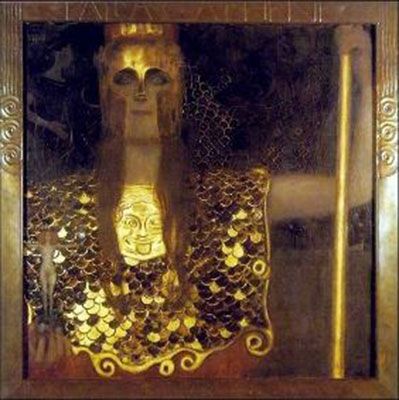
Pallas Athene
Though the Secessionists were known as a group that attempted to break with artistic traditions, their relationship with the past was more complex than a simple forward-looking mentality. Klimt, along with many of his fellow painters and graphic artists, cultivated a keen understanding of the symbolic nature of mythical and allegorical figures and narratives from Greece and Rome and other ancient civilizations. With his soft colors and uncertain boundaries between elements, Klimt begins the dissolution of the figural to abstraction that would come to full force in the years after he left the Secession. This painting exudes thus a sensory conception of the imperial, powerful presence of the Greco-Roman goddess of wisdom, Athena, and the inability of humans to fully grasp that, rather than a crisp, detailed visual summation of her persona.
Also significantly, the hazy quality of the image also allows Klimt to emphasize the goddess' androgynous character, a blurring of gendered identity that was featured in ancient descriptions and depictions of her, and explored by many other artists and cultural luminaries, at the turn of the century. She is dressed in the military regalia that traditionally identifies her as a warrior and the protector of her eponymous city, Athens - qualities normally associated with masculinity. Only the strands of hair that thinly drape down from each side of her neck (and almost blend with the golden color of her helmet and breastplate) give a hint as to her femininity. Barely visible at the left side of the painting, she holds the nude figure of Nike, representing victory, arguably the only clear feminine reference in the work.
The haziness evokes the contemporaneous exploration of dreams by Sigmund Freud, whose seminal work on the subject would be published in Vienna just two years later. It is tempting to read Klimt's painting in the context of Freud's view of dreams as the fulfillment of wishes, which might suggest that the powerful, imperious woman is the object of male desire, but also potentially that the traditional feminine persona must be costumed in order to attain such powerful status.
Oil on canvas - Collection of the Wien Museum, Vienna
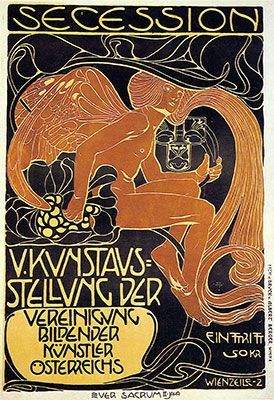
Poster for the Fifth Secession Exhibition
Moser's poster for the Fifth Secession Exhibition in 1899 is an oft-reproduced work of the Secession artists, and represents the full flowering of Moser's creative powers in Jugendstil (the German term for Art Nouveau) graphic design. Amazingly, the imagery here is lithographed in a set of just three colors - a pale yellow, dark green, and an old gold - and yet it conveys a clear sense of depth and figural plasticity. Moser's free use of line produces a rare seamlessness in the design that is difficult to achieve even within Jugendstil. The various regions of the poster are knit together by the vine-like whiplash curves that also fill nearly all of the negative space. Even the lettering, for example, blends thoroughly with the rest of the lines - in most cases, it is not even distinguished from the imagery by a separate border - and yet manages to stand out just enough to be entirely and easily legible. Thus Moser achieves a high degree of aesthetic unity without sacrificing functionality.
While there is an emphasis on nature, there is a mysterious, unknown quality that Moser has left behind: while we can see the central winged figure, it is difficult to define its identity precisely - is it a sprite, or an angel, or a godlike spirit, or something else? A similar character is exuded by the plantlike form he grasps - is it a set of grapes, or berries, or other fruit? The ambiguity of the imagery here acts as a leveler among the viewers, privileging nobody's knowledge over anyone else's. Like his Art Nouveau contemporary, Hector Guimard, who was designing his entrances to the Paris Metro at precisely the same moment, Moser uses the imagery here as a means to democratize the Secession's art, making it equally accessible and understandable to everyone. Its ambiguity acts as a teaser, drawing the viewer in to the exhibition and inviting him to explore the group's work more.
Lithograph
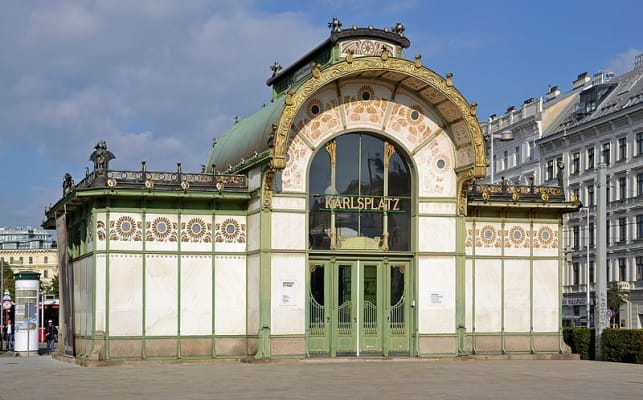
Karlsplatz Station, Vienna S-Bahn
Otto Wagner's stations for the Vienna Stadtbahn (city railway), designed also at the same time as Guimard's Metro stations in Paris, help inextricably link Art Nouveau with the technology of the age, which places it firmly in the context of contemporaneity that the Secessionists sought. They also exude the way that the many Art Nouveau artists and architects sought to break from the past to create a truly modern aesthetic.
It is difficult to say that Wagner completely succeeded on the second count here or in his other S-bahn stations. Here at Karlsplatz the familiar central archway, symmetrical balance, and columnar structure of previous architectures are all visible, but the frank expression of industrial materials and the unusual way in which those are combined with forms of nature - the green paint applied to the iron, making it look like abstracted or straightened vines, along with the flattened stenciling of the flower pattern - indicates a move in a different direction.
At this point, the fullest expression of technology as the defining aesthetic, along with the abandonment of the natural forms of Jugendstil, was yet to come from Wagner - one would have to wait for the completion of his Postal Savings Bank in 1904. Significantly, the evolution of the personal style of Wagner, who was Olbrich's teacher at the Academy of Fine Arts, indicates that he was willing to not only symbolically break with the past by joining the Secession, but also to incorporate such changes into his own practice. One can also see this in the way that Wagner's station here relies on three colors: gold, green, and white, reflective of the way that Jugendstil posters like those of Auchentaller and Moser were lithographed in three colors, and make liberal use of line to define otherwise flattened surfaces. We thus see the integral nature of artistic exchange among the Secessionists, even when they were not officially collaborating on the same work with one another.
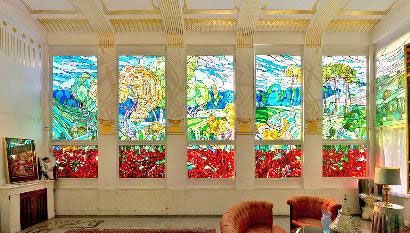
Vienna Woods in Autumn
Bohm, known mostly from his painting and graphic arts, completed the stained glass for the living room of the large villa that Otto Wagner built for himself on the outskirts of Vienna in 1885-86, nearly fifteen years before this commission was awarded. The completed room illustrates the concept of the Gesamtkunstwerk that was attractive to both the Secessionists and other contemporaneous styles and currents such as Art Nouveau and the Arts & Crafts Movement; in particular, it shows the collaborative nature of the format, as it required the viewer's immersion within an artistically-designed environment, usually pieced together by a group of specialists in a variety of media.
In this space, Bohm's work effectively represents the last piece of the puzzle (the others already designed by Wagner) to achieve that immersive effect. At once the stained glass windows' opacity closes off the living room in which they are installed from the outside world, yet the landscape they depict, which extends across all the panels, makes it seem as if the living room constitutes an exterior terrace or balcony that opens onto an infinite expanse of nature beyond. One could thus argue that Bohm's windows ironically create more of a connection of the space with nature than actually seeing nature itself through transparent windows; or, at the very least, that that closeness is heightened because natural light itself illuminates the windows during the day and bathes the space in radiant color. The effect, therefore, is to seem to freeze time at a singular moment of perfection, in which the natural environment has been captured in full bloom and preserved through the technological powers of art and architecture.
Stained glass - Wagner Villa I, Vienna
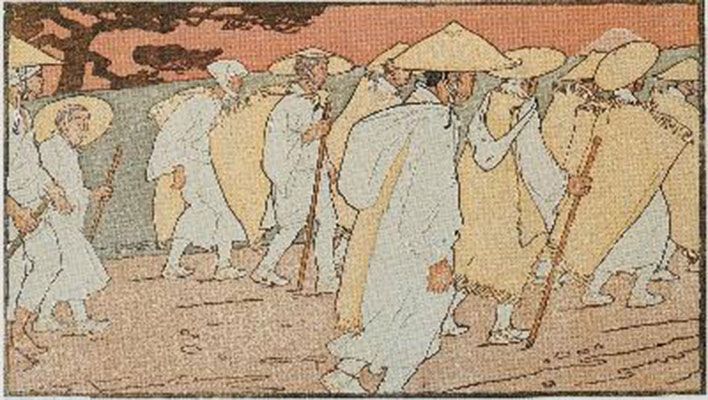
Pilgrims Approaching Mount Fuji
The Secessionists' fascination with Japanese art places them squarely within the more generalized Western attraction to Japanese culture that was spurred by the Japanese displays at world's fairs throughout the last half of the 19th century. These included Vienna's 1873 Weltausstellung, which first introduced Japanese products directly to an Austrian public.
Orlik's woodcut here, based on his own trip to Japan in 1900-01, highlights probably more clearly than nearly any other artwork produced by the Secessionists how the group was influenced by the art of the Far East. The woodcut itself is a defining technique of Japanese printmaking, as is the elongated horizontal orientation of the work, which also recalls the horizontal orientation of other Secessionist works, most conspicuously Klimt's Beethoven Frieze. The flattened planes and forms here (the tree in the background appears as essentially a silhouette), and uniform colors of the regions evoke the work of the great Japanese artists Utamaro and Hokusai, as does the limited color palette.
Nonetheless, there are significant ways in which Orlik here breaks with Japanese tradition. While many Eastern prints illustrate individual scenes from a larger narrative, leaving the viewer's imagination to fill in the visual aspects of the rest of the story, Orlik constructs this print with no greater framework behind it, merely as a genre scene. It is arguably less about the actions of the figures than an experiment with form, balance, color, and pattern, as there appears to be a rhythm of alternating white-and-beige regions of the figures' clothing as they are laid out across the image. In Orlik's print there is also a diminished emphasis on the landscape, which often dramatically frames or forms a backdrop to the figural narrative action of Japanese works; only the small peak of Mt. Fuji - which often forms a geographic anchoring purpose in Hokusai's works - is visible in the background here. Orlik's work, which focuses on ordinary subjects, carries a kind of Realist air, though it also appears empty of any political content or agenda.
Woodcut
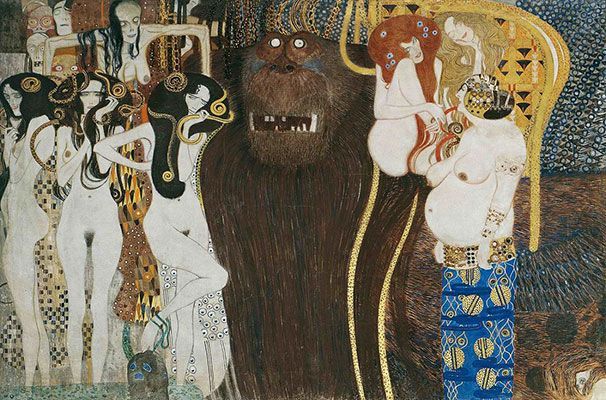
Beethoven Frieze
The Beethoven Frieze, only a detail of which is shown here, was painted by Gustav Klimt for the 14th Secession exhibition in 1902 - arguably the group's most famous - dedicated to the eponymous German composer who was a longtime Vienna resident. It is a monumental work, measuring some 7 feet tall by 112 feet long, and weighing 4 tons. Painted on the interior walls of the Secession Building, it was preserved but was not displayed again until 1986; and it is now permanently on view in the basement.
The main significance of the Beethoven Frieze is that it forms part of the exhibition-as-Gesamtkustwerk, or total artistic environment that the Secessionists sought to create. For them, this often included all branches of the arts - not simply the visual arts, but also the performing arts, such as symphonic works, theater, and opera; accordingly, the contemporary Viennese composer Gustav Mahler's adaptation of Beethoven's Ninth Symphony was playing at the opening of this exhibition of the Secession. The Gesamtkunstwerk is underscored by details such as the incorporation of gems into the painted surfaces to add to the shimmering effects.
The frieze's narrative tracks the narrative of three female figures, called Genii, that represent humanity seeking fulfillment. They rely on a gigantic knight in shining armor - said to be representative of a great leader for the German-speaking countries of Europe - to lead them through a harrowing minefield of characters, including the ones seen in the excerpt above, whose elongated and exaggerated forms at once reference the Gorgons like Medusa from Greek mythology and represent disaster and vices such as sickness, madness, death, intemperance, and wantonness. Fulfillment does come at the end, represented by a pair of nude female and male figures locked in an almost erotic embrace in a golden aura, surrounded by a choir, a reference to the choral performance of Schiller's poem "Ode to Joy" at the end of the Ninth Symphony.
Despite the modern notion of the Gesamtkunstwerk, the reliance on very old tropes - not only figures from Greek mythology but the flattened depictions of figures like those seen on ancient Greek vases - demonstrate the range of influences on the Secessionists. It also suggests their desire to synthesize a contemporary art from old and new, innovation and tradition, which responds to the hopes and desires of contemporary society.
Fresco
Beginnings of The Vienna Secession
Background
At the close of the 19th century, Vienna was one of the two capitals of the old Habsburg-ruled Austro-Hungarian Empire (also called Austria-Hungary), which was essentially a patchwork of regions home to different nationalities in Eastern and Central Europe, dominated by Austria and, since 1867, Hungary (which after a revolt against Austrian hegemony forced the Hapsburgs to accept Hungary as an equal partner above the other ethnic groups within the empire). Nonetheless, the Empire remained one of the least-industrialized and most conservative economic, social, political, and cultural great powers within Europe, as personified in its ruler, Franz Joseph I, who remained on the throne for 68 years until his death in 1916.
Though the empire included a number of different metropolitan areas, Vienna had long been the undisputed capital in all important aspects of the Empire's existence. The Empire remained largely rural, and the increasingly diverse number of artistic groups elsewhere in Europe throughout the last half of the century that began to grapple with a new, industrialized and modern world prompted many artists in Vienna to reexamine the entrenched artistic institutions and practices within their city and the Empire at large. It was also a very tumultuous time in Vienna, in the next few years many creative and powerful thinkers made it home: Sigmund Freud, a native of the city developed his theories there, Adolf Hitler and Leon Trotsky lived there, and the composer Arnold Schoenberg developed his radical melodic ideas in the city.
Formation
The Secession grew out of dissatisfaction of a group of artists with the system of expositions of contemporary art in the city during the 1890s. These shows were controlled by the Association of Austrian Artists, which ran the Kunstlerhaus (Artists' House) - the only municipal venue for them - and favored the conservative artists who made up a majority of its members, and generally discouraged its members' efforts in the decorative and applied arts, which at the time were gaining ground in prestige relative to the traditional fine arts of painting and sculpture.
Such issues were among those discussed by smaller groups of the young progressive artists within the Association, who began meeting in the mid-1890s in coffee houses and cafes, the famous Viennese nodes of intellectual discourse then, and even today. They included the painters Carl Moll and Koloman Moser, and architects such as Joseph Maria Olbrich and Josef Hoffmann, the latter two of which were students of the established architect Otto Wagner, the head of the architecture department at the conservative Vienna School for Fine Arts.

Feeling that their voices of progressivism would never be heard otherwise, on April 3rd, 1897 these younger artists announced their intention to form a new organization specifically for the purposes of creating a venue for their work, especially the decorative arts, and to encourage contact with foreign practitioners. They sought approval from the Association of Austrian Artists, but were turned down, and so formally resigned from it, thus creating a new organization, the Vienna Secession. The painter Gustav Klimt, at the time already of international renown, was elected the first president. Besides Klimt, the Secession from the outset included names such as Olbrich, Hoffmann, Moser, Moll, Max Kurzweil, Wilhelm Bernatzik, Josef Maria Auchentaller, and Ernst Stöhr.
Goals and Principles
On a basic level, the Secessionists sought a venue that gave their art greater exposure, both with the general public and with collectors. Vienna generally eschewed the independent dealer system and few public commissions were awarded after the completion of public buildings on the Ringstrasse by the 1880s as there was little need for them. The Kunstlerhaus, meanwhile, had taken a 10% commission on works sold there and favored the display of conservative artworks which catered to established public tastes. The artists of the Secession wanted very much to free themselves from the commercialism of that art world. As Hermann Bahr described it in the first issue of Ver Sacrum:
"Our art is not a fight of modern artists against old ones, but the promotion of arts against the peddlers who pass for artists and have a commercial interest that prevents art from flourishing. Commerce or art, that is the issue before our Secession. It is not an aesthetic debate, but a confrontation between two states of the spirit."

Though the source of the Secession's complaints with the existing structure of artistic institutions in Vienna was an economic and conceptual issue, the other issues that rankled them were many. Accordingly, from the outset Secession artists postulated several goals for their group. They intended to:
* Reunite the creative minds of the nation
* Make contacts with artists internationally and promote an exchange of ideas
* Campaign against the nationalist spirit amongst European countries
* Renew the applied and decorative arts
* Create a "total art" (that is, they were committed to the idea of the Gesamtkunstwerk, or complete artistically-designed environment)
* Create a new artistic expression that was specifically opposed to the inferior art of the official Vienna salons
The objectives were self-consciously forward-looking and attempted to break with the past and national traditions, and clearly hoped to inject some new, outside thinking into a system that for them had become old and stale.
The New Building

The structure that is to this day still synonymous with the movement as a whole, is also one of the buildings that anchors the city's cultural district.
The Secession secured land from the city to build an exhibition venue in the cultural district near the Ringstrasse, the series of broad boulevards that encircled the city center. The building ensured that the Secession remained in the public eye both as a permanent architectural monument to the movement's existence and as the host site for the frequent shows by its direct members and foreign artists alike.
Built on the site of an old vegetable market, the Secession Building was strategically located near a number of important civic and national institutions, including the Academy of Fine Arts, the Vienna Museum of Fine Arts, the Municipal Concert Hall, the Technical University of Vienna, and the Kunstlerhaus itself. The task of designing the Secession's new venue fell to the young architect Joseph Maria Olbrich, a former student of Otto Wagner, representing Olbrich's first significant independent commission. The Secession gained significant credence in 1898 when Wagner, long considered by his fellow faculty at the Austrian Academy of the Fine Arts as a staunch conservative, joined the group, thereby shocking the establishment.
Ver Sacrum
In January 1898, the Secession began publishing its own journal, Ver Sacrum, which appeared on a monthly basis until January 1900, when it was issued twice monthly (24 issues per year), with its length reduced to twenty pages. It thus became something more like a regular bulletin than a magazine. Its publication continued regularly until December 1903, when it ceased due to the lack of subscribers.
The decision to found a journal to disseminate the movement's work and ideas was not new or different from many artistic organizations or collectives of the period, but to some extent this aspect worked to its advantage, since the establishment of a formal organ to publicize it was useful in establishing the Secession's seriousness and credentials immediately, as it was well-received by critics at home and abroad. It occasionally created controversy, however: one issue was confiscated by prudish local authorities because the depiction of nudity in a Klimt work published in it "created a public outrage," to which Klimt responded that it was more important to him that his own patrons liked the work.
Ver Sacrum's title translates from Latin as "Sacred Spring," and refers to the legends from antiquity, particularly from the Romans, concerning rituals for the foundation of new colonies from existing cities - communities vowed to the god Mars that they would expel the generation of children born the following spring when they reached roughly 20 years of age to form their own community.

The association of the Secession with this ritual can be symbolically explained by the cover of the first issue of Ver Sacrum, designed by Alfred Roller, in which one sees a tree reaching maturity, with roots shattering the pot in which it has heretofore been planted. It thus forms a parallel with the way that the young artists of the Secession broke the "mold" within which they had been cast when they had reached maturity in order to properly flourish. On the cover within the tree branches are three shields that represent the traditional fine arts of painting, sculpture, and architecture (somewhat ironic given the Secession's emphasis on contemporary and decorative arts). The tree or wreath imagery adorned with three shields would appear periodically throughout Ver Sacrum's run.

Ingeniously, Ver Sacrum was produced in a nearly-square format, unlike virtually every other major periodical of the era (or today), which allowed for it to accommodate a wide variety of artistic media. During its six-year run, no two covers were alike; the editorial team (whose precise makeup was not reported, though it included painter Alfred Roller; the critic Hermann Bahr; director of the Burgtheater, Max Burckhard; and Wilhelm Scholermann) offered it to different artists with every issue, in effect giving a large percentage of the group's members top billing.
Ver Sacrum featured much of the artistic output of the Secession's artists, shown both in photographs of the Secession's exhibitions and their graphic output, but the texts, both by critics and some of its artists, largely focused on other artistic subjects, such as the history of Japanese art or the work of influential foreign artists, such as Aubrey Beardsley. Klimt himself was one of the major contributors to the journal. Despite its limited run of 300 copies per issue - which in some ways helped make each issue itself a valuable art object - Ver Sacrum helped fulfill the goal of the Secession of broadening their own and the nation's artistic horizons by making connections internationally.
The Vienna Secession: Concepts, Styles, and Trends
Relationship with Art Nouveau
At the time, the rise of Jugendstil/Art Nouveau - which became evident in Olbrich's design for the Secession's new building and would soon find expression in Wagner's work - was the trend throughout Europe. Most of the Secessionist artists worked to varying degrees in Art Nouveau during the movement's early years. The Secession in a historical context is thus often thought of as the Austrian branch of Art Nouveau/Jugendstil (especially since Art Nouveau died out in most European countries about the same time that the Secession itself declined precipitously).

The characteristics of Jugendstil / Art Nouveau had much in common with the tenets of the Secession. The names "Art Nouveau" (New Art) and "Jugendstil" (Youth Style) speak to the notion that the style was the wave of the future and represented a break from the stodginess of the past, obviously a goal that the Secession shared. Art Nouveau artists often encouraged international exchanges of ideas, another stated goal of the Secession, and often Jugendstil designers sought to broaden the reach of or to democratize art, to make it accessible - or at least understandable - to people of all classes and backgrounds. In both Art Nouveau and the art of the Secessionists, there is an emphasis on nature, but usually in a way that abstracts or stylizes it from a veristic representation.
Because the Secession emphasized contemporary art rather than a particular style, it is logical that the group moved away from Art Nouveau as the style itself died out (thus in some ways the Secession is constantly "reinventing" itself). Nonetheless, many Austro-Hungarian, German, or Italian Art Nouveau works from this period (roughly 1895-1905) are labeled as "Secessionstil" or "Sezessionstil" because of their resemblance to the Jugendstil work of the Vienna Secession. Its concern with the complete environment that integrated the traditional fine arts with the decorative and even the performing arts (particularly music and theater) distinguished it from the later Berlin Secession (founded 1898) and earlier Munich Secession (1892), both of which emphasized painting almost exclusively.
Japanese Influence

Also like Art Nouveau, the Secession was greatly influenced by Japanese art and design, which had first been introduced to Vienna in 1873 when the city hosted its only world's fair - the first to be held somewhere other than London or Paris.
Japanese artistic influence can easily be detected in the work of the Secessionists. Klimt and other painters favored the exaggerated vertical forms for figures in their paintings. The flattened forms of figures, spatial depth, and three-dimensional objects mimic those of Japanese designers. In some cases, such as the advertisement for the 6th Secession exhibition in 1900, Japanese prints were literally appropriated as the illustration featured on an extremely elongated vertical poster. The entire show was devoted to Japanese art.
Secessionist artists saw many parallels between their own art and that of Japan: the complete, designed environment, or Gesamtkunstwerk; the sense of abstraction and the balance between positive and negative space; the interest in the square and elongated vertical formats; and the emphasis on handcraft as opposed to the machine-made and mechanical reproduction. The latter was especially important in Austria-Hungary, an empire which was largely rural and where few centers of industry existed outside of Vienna; instead, folk art and crafts dominated provincial life.
Relationship with Ancient Art
At the beginning, the Secession was an avant-garde group that presented itself as such, hoping to make a clear break from the art of the past. But anyone who saw the Secessionists' work from the first decade of its history would have noticed the clear links with ancient themes and narratives. The title of Ver Sacrum and its analogous thematic associations were, as noted above, clearly derived from Roman sources, particularly the idea of seceding from a community to found another.
The Secession Building itself is filled with classical associations. Above the main entrance, one can find reliefs of the three Gorgons, including Medusa, who were supposed to correspond to the three branches of the fine arts (painting, sculpture, and architecture). The entangled snakes of their hair suggest the seamless harmony between the various arts. Both the design of the facade and the interior use a symmetry that strongly reflects those of early Christian basilicas from the late Roman era. The buildings of Otto Wagner carried out during the golden era of the Secession largely reflect a kind of presence and balance normally associated with classical structures, and the kinds of figural sculpture to accompany them, largely produced by Othmar Shimkowitz, exude a classical formality, replete with figures draped in togas or classical gowns and holding wreaths, or narrative scenes played out in long relief friezes.
The blending of old and new carried a certain significance for the Secessionists' mission, but it was also very likely a necessary convenience in order to ensure their relevance for their audience, whose familiarity with contemporary art would have been thin, especially at the moment that the Secession was founded. Instead, most cultured Viennese citizens would have been familiar with the narratives and traditions of classical antiquity, which at the turn of the century still formed the basis of a well-rounded Western education, particularly in German-speaking countries.
Exhibitions and Foreign Links
The Secession's exhibitions became the organization's primary way of disseminating its avant-garde message. Until 1905, the exhibitions were organized by Klimt, Hoffmann, and Carl Moll. The first exhibition in March 1898, held before the official Secession Building was completed, drew some 57,000 visitors, including the Emperor Franz Joseph, a significant feat considering that Franz Joseph was not known for his interest in art and what taste he did exhibit favored the old-fashioned and conservative.
Opened in October 1898, the Secession Building hosted four exhibitions a year, a grueling schedule, but one that permitted the Secessionists to both introduce their own art and explore foreign works. The most famous of these was the 14th exhibition in 1902, which was dedicated to longtime 19th-century Vienna resident and composer Ludwig van Beethoven. For this exhibition, Josef Hoffmann designed the galleries and Gustav Klimt created his famous Beethoven Frieze, a thirty-four-meter-long fresco dedicated to the composer but featured in an adjoining space to the central hall.
The Secession's frequent exhibitions invited artists from abroad, who were altogether usually highly enthusiastic about presenting their work in one of the great European capitals of culture, particularly one in which many of them had not exhibited before. Most notably, in 1900 the Secession welcomed Scottish designers Charles Rennie Mackintosh, his wife Margaret, and Herbert and Frances McNair, collectively known as the "Glasgow Four," whose highly geometric, often rectilinear forms were well-received by Austrian designers; other British artists such as Charles Robert Ashbee were also featured in the same show. Similar influences could be traced to the designers of the British Arts & Crafts Movement, whose work was known for its emphasis on utility and simplicity. The Secession, however, was not an organization designed for the explicit promotion of any one style; instead, it was a venue dedicated for the promotion of contemporary art in all fields.
The participation of foreign artists in the Secession's exhibitions helped lend extra credibility to their work amongst the general public, both at home and abroad. To cement the organization's reputation, from the start the Secessionists also created the rank of corresponding membership for foreign artists who exhibited. Today this list includes an impressive bevy of names: James Abbott McNeill Whistler, Henry van de Velde, Auguste Rodin, Heinrich Tessenow, Pierre Puvis de Chavannes, Henry Moore, Edward Burne-Jones, Henri Cartier-Bresson, Jean Dampt, Frank Brangwyn, Jan Toorop, Rupert Carabin, and Anders Zorn, among others. Corresponding membership is also open to "individuals (writers, publicists, curators, etc.) who are friends of the Secession and have made significant contributions to the arts and their preservation."
Architecture
The only four architects to join the Secession in its first two years of existence were Olbrich, Hoffmann, Julius Mayreder, and Otto Wagner. As Olbrich left Vienna in 1899 for the Darmstadt Artists' Colony, Hoffmann only completed a few small residences before 1903, and Mayreder favored a much more Baroque style, it is nearly impossible to speak of an individual "Secession Style" or set of defining characteristics of the buildings.
Much of the architecture associated with the Secession consists, therefore, of Wagner's own practice between 1898 and 1905. In these seven short years, however, Wagner designed some of his most iconic works: the stations for the new Vienna Metropolitan Railway, (Vienna Stadtbahn, 1898-99); the Majolikahaus apartment building (1898), the Steinhof Church (1904-07) and the Austrian Postal Savings Bank (Postsparkasse, 1904). Wagner had affirmed his allegiance to the Secession in June 1899, when he was nearly 60 years old, and his buildings from the turn of the century vacillate between the classicism of his training and longtime practice, on the one hand, and affinities for Jugendstil and a technological modernism that expresses a fascination with industrial materials and forms.
Graphic Art
The Secession's graphic output was prodigious, spurred on by the publication of Ver Sacrum, which inherently welcomed two-dimensional works on paper. It was also aided by the group's general interest in Japanese art and the advertising that the group produced for its own exhibitions, each of which demanded its own poster. Many of these now rank among the best-known works of Jugendstil/Art Nouveau design from the turn of the century.

The vast majority of the Secessionists were themselves painters, printmakers, or graphic artists of another variety. They were fortunate to be working during essentially the golden age of poster development, when color photography had not yet been invented, but the perfection of technology for high-volume color lithography had just been achieved. Thus, the large-scale designs for the Secession's graphic work constituted the most prominent and widely-disseminated examples of their art.
The Secession's prominence in graphic design declined sharply after 1903 due to the formation of the Wiener Werkstätte that year and the cessation of publication of Ver Sacrum. The former poached Moser, the Secession's leading graphic artist, who formally quit the Secession two years later with Klimt and others (though he would move on from the Werkstätte too in 1907). The Werkstätte itself would go on to produce some of its own very notable example of typography and graphics, including its famous and very collectible postcards.
Later Developments - After The Vienna Secession
Decline
Despite their attempts to promote contemporary art and the equality amongst the arts against base institutional commercialism, the Secessionists could not extricate themselves from the question of economics. This came to the forefront in two instances in the middle of the first decade of the 20th century.
The first concerned the decorative or applied arts, which the Secession certainly promoted, but almost inherently - due to the utilitarian nature of its genre - required a commercial outlet to survive. In 1903, the architect Josef Hoffmann and the designer Koloman Moser formed - without resigning from the Secession - the Wiener Werkstätte (Vienna Workshops), a union of artists-craftsmen dedicated solely to the artistic production and marketing of these kinds of goods, underwritten by the fortune of Fritz Warendorfer, a member of a family of textile magnates. With the energies of two of its most brilliant members focused elsewhere, the Secession could no longer claim to be the center for Austrian decorative arts.
The second blow to the Secession came two years later, and was more serious. It arose from a proposal by Klimt that, in order to reach a buying public, the Secession purchase the Gallery Miethke in order to effectively market its work. His suggestion (whose supporters have been called the "Stylists" - as opposed to the "Naturalists," primarily easel painters), however, lost, and so on 14 June 1905, Klimt, Koloman Moser, Auchentaller, and several other prominent members (often called the Klimtgruppe) formally resigned. This break shattered the Secession, as it lost virtually all of its most accomplished members, including Klimt. Klimt worked thereafter unaffiliated with any other group of artists until his death in 1918, though he remained close to both Hoffmann and Moser and was invited to create several works in collaboration with the Wiener Werkstätte, such as his monumental Tree of Life murals for the dining room of the Palais Stoclet in Brussels, finished in 1911.
The departure of the duo of Klimt and Moser, in particular, also deprived the Secession of the possibility of adding their brightest pupils to its ranks, as both Klimt and Moser were known for mentoring highly talented younger artists, such as Egon Schiele, Oskar Kokoschka, and Jutta Sika. Schiele and Kokoschka would go on to become accomplished artists in their own right, and might be best categorized as some of the earliest Expressionists in Austria. The year 1918 was especially harsh for Austrian art, as Klimt, Moser, Wagner, and Schiele all went to their reward, the latter due to the great influenza pandemic.
The Secession Since 1905
The Secession's fortunes have waxed and waned since its founding. It is a testament to its members' commitment that it did not dissolve in 1905 after the Klimtgruppe seceded, but it was never able to regain the prestige that it had previously enjoyed. The members of the Klimtgruppe joined other artistic societies, many of which were intended to unite artists in all German-speaking countries. These in some ways usurped the Secession's mission to function as the bridge to foreign artists' work and encourage artistic exchange.
Nonetheless, the Secession did continue to contribute to the international dialogue among contemporary artists. An exhibition on modern art in 1924, for example, brought together a number of the masters of the era, including Picasso, El Lissitzky, and Piet Mondrian, and a retrospective of English painting from the previous three hundred years, held in 1927, brought a record number of visitors.
The Secession also continued to attract new members, in some cases artists and designers with significant prestige. The great German architect Peter Behrens, for example, joined in 1938, albeit just two years before his death. Oskar Kokoschka was still a student when the Secession was at its peak but had been mentored by many of its formal members at the School of Arts and Crafts (Kunstgewerbeschule) and later worked in concert with the Weiner Werkstätte before 1932. He, however, did not join the Secession until 1945, while he was living in Great Britain in exile, and would not return to Austria, living in Switzerland until his death in 1980.

The Secession Building, a key symbol of modernist art in Austria, was purposely burned by the anti-modern Nazis during World War II, but it was rebuilt in the aftermath of the conflict. Josef Hoffmann even served as president of the Secession in 1948-49, long after the Wiener Werkstätte, which he had co-founded as an offshoot of the Secession, had collapsed.
In 1984-85, the Secession Building itself underwent a significant renovation, one which restored Klimt's own Beethoven Frieze to permanent exhibition in the basement. The main exhibition space began, over the next several years, to host shows by several cutting-edge artists. Hermann Nitsch installed a series of paintings that recalled the spirit of the Gesamtkunstwerk pursued by the Secession's founders. Some two and a half years later, Joseph Kosuth curated the artistic section of an exhibition on the philosopher Ludwig Wittgenstein, whose father had been one of the Secessionists major backers at the beginning of the century. The arrangement of paintings, in the manner of a large continuous panorama, paid homage to the Beethoven Frieze. Klimt's work has served as the inspiration behind several other contemporary artists' ideas for exhibitions in the Secession Building, including Sol LeWitt and Daniel Buren, both of whom are famous for their works that critique the traditional notions of museum and gallery spaces. The Secession's general exposition policy is to favor artists who have ideas on how to engage with specifically the site and the history of the organization.
The Secession remains the only exhibition venue entirely managed by artists in Austria; it is run by a board of twelve artists. In recent years, it has been the subject of numerous tributes, including two separate Euro coins. In 2004, the European Union issued a 100-euro commemorative coin featuring the Secession building on the obverse and a detail of Klimt's Beethoven frieze on the reverse. The regular-issue Austrian 50 Euro Cent coin, meanwhile, features a detail of the dome and entrance of the Secession building, symbolizing the dual births of Jugendstil and the near-simultaneous new century.
Useful Resources on The Vienna Secession
- Art in Vienna 1898 - 1918: Klimt, Kokoschka, Schiele and their contemporaries (2015)Our PickSnapshot of the prominent works of the movement
- Vienna Secession 1898 - 1998: The Century of Artistic Freedom (1998)A look at the various exhibitions and exhibited works of the Vienna Secession
- Viennese Secession (Art of Century Collection) (2011)By Klaus Carl and Victoria Charles
- Fin-De-Siecle Vienna: Politics and Culture (1980)Our PickBy Carl Schorske
- Ornamental Posters of the Vienna Secession (1974)By Horst-Herbert Kossatz and Walter Koschatzky
